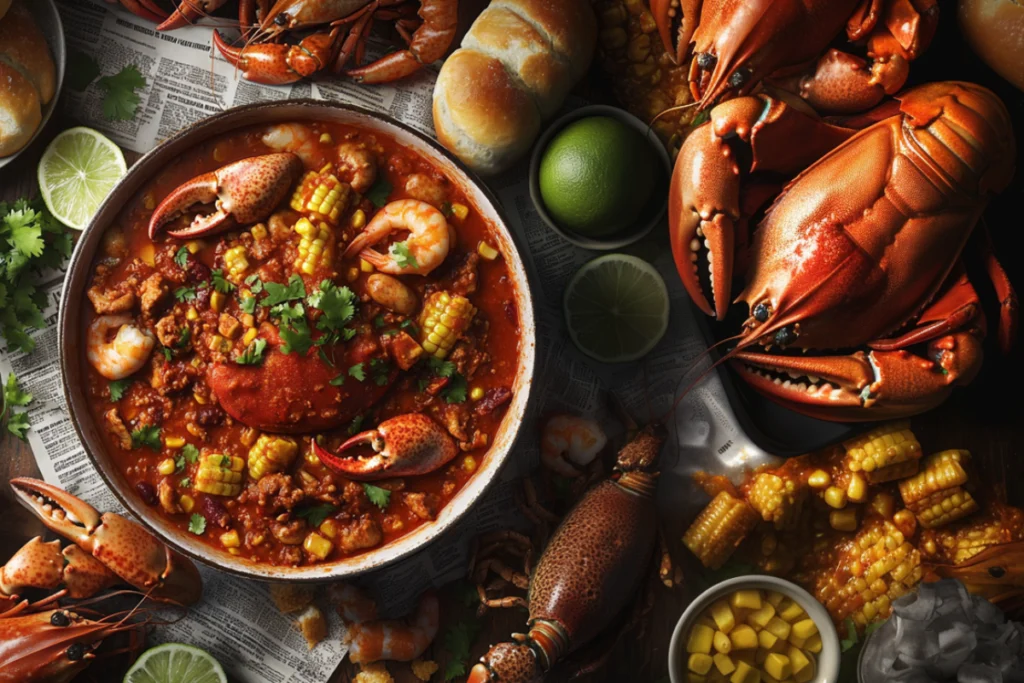
Seafood boil sauce is an essential part of the classic seafood boil experience, giving each bite of shrimp, crab, crawfish, or lobster an extra punch of flavor. This sauce is typically rich, buttery, and packed with spices that enhance the natural sweetness of seafood. In this article, we’ll dive deep into the core ingredients of seafood boil sauce, explore popular variations, and offer tips for customizing the sauce to suit different tastes.
For those looking to add a sweet and spicy twist, Ultimate Guide to Making Hot Honey – A Sweet and Spicy Delight provides inspiration for infusing seafood boil sauce with a hint of heat and sweetness.
Essential Ingredients in Seafood Boil Sauce
At its core, a great seafood boil sauce combines a few essential ingredients that create a perfect balance of richness, spice, and acidity. Here’s a breakdown of these foundational components:
- Butter: Butter is the backbone of most seafood boil sauces, providing a rich, creamy base that coats the seafood and carries other flavors well.
- Garlic: Fresh garlic infuses the sauce with an aromatic depth that enhances the flavor of the seafood.
- Cajun or Old Bay Seasoning: These spice blends are classic in seafood boils, bringing a mix of heat, smokiness, and savory notes that elevate the sauce.
- Lemon Juice: A splash of lemon juice adds brightness to the sauce, balancing the richness of the butter with a refreshing acidity.
- Paprika: Smoked or sweet paprika adds a touch of earthiness and color, contributing to the sauce’s overall depth.
- Hot Sauce: Optional but common in many recipes, hot sauce adds a spicy kick, especially in Cajun-style sauces.
These ingredients create the fundamental flavor profile of a traditional seafood boil sauce. Each element adds depth, from the creamy butter to the zesty lemon, creating a sauce that enhances the seafood rather than overpowering it.
Popular Types of Seafood Boil Sauce
There are several variations of seafood boil sauce, each with unique flavors that pair well with different types of seafood. Here’s a closer look at some popular types of seafood boil sauces.
1. Classic Cajun Seafood Boil Sauce
Cajun seafood boil sauce is a Southern favorite, known for its bold and spicy flavors. This sauce pairs especially well with crawfish, shrimp, and crab, giving the seafood a robust, smoky kick.
- Ingredients: Butter, garlic, Cajun seasoning, smoked paprika, lemon juice, and hot sauce.
- Flavor Profile: Spicy, smoky, and buttery, with a hint of tang from the lemon.
- Best Pairings: Crab, crawfish, shrimp.
For a comprehensive look at this classic sauce, Cajun Seafood Boil with Garlic Butter Sauce offers a recipe that captures the essence of Southern seafood boils.
2. Garlic Butter Sauce for Seafood Boils
Garlic butter sauce is a milder option that focuses on the natural flavors of garlic and butter. This sauce is perfect for those who prefer a less spicy option, as it highlights the seafood’s sweetness without overpowering it.
- Ingredients: Butter, garlic, salt, black pepper, lemon juice, and fresh parsley.
- Flavor Profile: Rich, creamy, and aromatic, with a subtle zing from the lemon.
- Best Pairings: Lobster, shrimp, crab.
Garlic butter sauce can be customized by adding lemon zest or even a splash of white wine for extra depth.
3. Lemon Herb Seafood Boil Sauce
For a fresher, lighter take, a lemon herb seafood boil sauce combines the richness of butter with bright citrus and fresh herbs, making it ideal for pairing with more delicate seafood.
- Ingredients: Butter, lemon juice, garlic, fresh herbs (such as parsley, dill, or thyme), and salt.
- Flavor Profile: Light, refreshing, and tangy, with a hint of earthiness from the herbs.
- Best Pairings: Clams, mussels, and shrimp.
This sauce enhances the flavors of shellfish without overwhelming them, making it an excellent choice for those who enjoy a citrusy twist.
4. Asian-Inspired Seafood Boil Sauce
For a unique fusion, an Asian-style seafood boil sauce incorporates ingredients like soy sauce, ginger, garlic, and chili paste, offering a savory, umami-rich flavor profile.
- Ingredients: Soy sauce, garlic, ginger, chili paste, sesame oil, and butter.
- Flavor Profile: Umami-forward, slightly spicy, with a rich savory undertone.
- Best Pairings: Lobster, crab, shrimp.
This Asian-inspired sauce adds a fresh take on the traditional boil, appealing to those who enjoy bold flavors with a hint of sweetness.
Tips for Customizing Your Seafood Boil Sauce
One of the best aspects of seafood boil sauce is its versatility, allowing you to tailor it to suit your preferences. Here are a few ways to make the sauce your own:
- Adjust the Spice Level: Increase the heat by adding more Cajun seasoning, hot sauce, or a pinch of cayenne pepper. To tone down the spice, reduce these ingredients and add a bit of honey for a subtle sweetness.
- Try Different Herbs: Fresh herbs like dill, parsley, and thyme can add depth and freshness to the sauce, particularly in lemon herb or garlic butter sauces.
- Experiment with Citrus Zest: Adding lemon, lime, or even orange zest brings a bright note that complements the sauce’s richness, perfect for lighter seafood dishes.
With these adjustments, you can create a sauce that matches the flavor profile you’re looking for, making each seafood boil a unique and memorable experience.
How to Serve and Store Seafood Boil Sauce
Serving and storing seafood boil sauce properly is crucial to enjoy its flavors fully. Here’s a guide to make the most of your sauce:
- Serving Tips: Serve the sauce warm, either as a dip or drizzle it over the seafood boil. Keep extra sauce on hand for guests who may want more flavor.
- Storage Guidelines: Store any leftover sauce in an airtight container in the fridge for up to 3 days. When reheating, do so gently over low heat to avoid separating the butter.
To prepare ahead, consider freezing portions of the sauce for future use. This way, you can easily access it whenever you’re ready to enjoy a seafood boil.
For advice on adjusting sauce thickness, How to Thicken Up a Dipping Sauce – The Complete Guide offers helpful tips to perfect your sauce’s consistency.
Frequently Asked Questions About Seafood Boil Sauce
1. What are the main ingredients in seafood boil sauce?
Typically, seafood boil sauce includes butter, garlic, Cajun seasoning, lemon juice, and optional spices like smoked paprika and hot sauce for added flavor.
2. Can seafood boil sauce be made vegan?
Yes, plant-based butter alternatives can be used, and soy sauce can replace Worcestershire sauce for a vegan-friendly option.
3. What seafood pairs best with each type of boil sauce?
Cajun sauce complements crab and shrimp well, garlic butter works best with lobster, and lemon herb sauce pairs nicely with lighter shellfish like mussels and clams.
4. How long does seafood boil sauce last in the fridge?
When stored in an airtight container, seafood boil sauce will keep in the refrigerator for up to 3 days.
5. Is there a way to make a low-sodium version of seafood boil sauce?
Yes, you can use unsalted butter and low-sodium seasonings to control the salt content without sacrificing flavor.
Conclusion: Perfecting Your Seafood Boil Sauce
Seafood boil sauce is more than just a condiment; it’s an essential addition that brings out the best in every seafood boil. From the heat of Cajun spice to the richness of garlic butter and the refreshing tang of lemon herb, there’s a sauce to match any preference. By experimenting with ingredients like spices, herbs, and citrus, you can create a sauce that enhances your seafood experience.
For additional ideas and flavor inspiration, Ultimate Guide to Making Hot Honey – A Sweet and Spicy Delight offers creative ways to bring a sweet and spicy element to your sauce.
This guide provides a complete overview of seafood boil sauce, from essential ingredients to creative variations and helpful tips for customizing it to suit your taste. Whether you’re preparing a family feast or hosting friends, a well-crafted seafood boil sauce is sure to impress!
